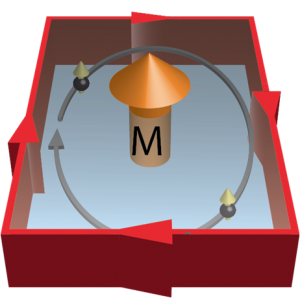Topological devices as an enabler of dissipationless electronics Quantization rule is elucidated for “Quantized Anomalous Hall Effect”

When a strong magnetic field is applied to a layered semiconductor device, a current flow emerges without any energy loss at the edge of the sample (edge current). This phenomenon, called the “Integer Quantum Hall Effect,” is expected to find applications in low-power-consumption electronic devices. However, the Quantum Hall Effect has a drawback in that a strong magnetic field must be applied for it to arise.

© 2014 M. S. Bahramy.
Magnetic topological insulators can host the quantum Hall effect in absence of a magnetic field, where a current flow emerges without any energy loss at the edge of the sample.
Topological insulators are a new class of semiconductor that are insulating in bulk but possesses a conducting metallic surface layer. When topological insulators are doped with magnetic ions, ferromagnetism emerges in the interior of the material . Owing to the novel interaction of the surface metallic states and ferromagnetism, magnetic topological insulators can host the quantum Hall effect in absence of a magnetic field. This is called the “Quantized Anomalous Hall Effect”, where the edge current emerges without the external application of magnetic fields. Since the Quantized Anomalous Hall Effect does not need any magnetic fields, this quantum phenomenon is expected to find applications in electric devices employing edge current.
Researchers at the Graduate School of Engineering Department of Applied Physics at the University of Tokyo, headed by Professor Yoshinori Tokura, in collaboration with former lecturer Joseph Geroge Checkelsky, PhD candidate Ryutaro Yoshimi and Professor Masashi Kawasaki, have fabricated thin films of Cr-doped magnetic topological insulator [Cr0.22(Bi
Paper
J. G. Checkelsky, R. Yoshimi, A. Tsukazaki, K. S. Takahashi, Y. Kozuka, J. Falson, M. Kawasaki and Y. Tokura,
“Trajectory of the anomalous Hall effect towards the quantized state in a ferromagnetic topological insulator”,
Nature Physics Online Edition: 2014/8/18 (Japan time), doi: 10.1038/nphys3053.
Article link
Links
Graduate School of Engineering
Department of Applied Physics, Graduate School of Engineering
Quantum-Phase Electronics Center, Graduate School of Engineering
Department of Applied Physics, Tokura Laboratory, Graduate School of Engineering







